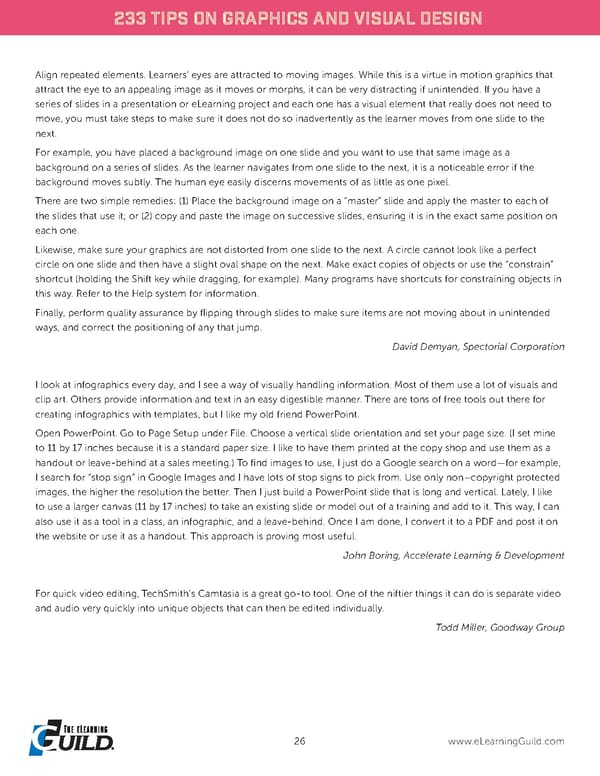233 TIPS ON GRAPHICS AND VISUAL DESIGN Align repeated elements. Learners’ eyes are attracted to moving images. While this is a virtue in motion graphics that attract the eye to an appealing image as it moves or morphs, it can be very distracting if unintended. If you have a series of slides in a presentation or eLearning project and each one has a visual element that really does not need to move, you must take steps to make sure it does not do so inadvertently as the learner moves from one slide to the next. For example, you have placed a background image on one slide and you want to use that same image as a background on a series of slides. As the learner navigates from one slide to the next, it is a noticeable error if the background moves subtly. The human eye easily discerns movements of as little as one pixel. There are two simple remedies: (1) Place the background image on a “master” slide and apply the master to each of the slides that use it; or (2) copy and paste the image on successive slides, ensuring it is in the exact same position on each one. Likewise, make sure your graphics are not distorted from one slide to the next. A circle cannot look like a perfect circle on one slide and then have a slight oval shape on the next. Make exact copies of objects or use the “constrain” shortcut (holding the Shift key while dragging, for example). Many programs have shortcuts for constraining objects in this way. Refer to the Help system for information. Finally, perform quality assurance by flipping through slides to make sure items are not moving about in unintended ways, and correct the positioning of any that jump. David Demyan, Spectorial Corporation I look at infographics every day, and I see a way of visually handling information. Most of them use a lot of visuals and clip art. Others provide information and text in an easy digestible manner. There are tons of free tools out there for creating infographics with templates, but I like my old friend PowerPoint. Open PowerPoint. Go to Page Setup under File. Choose a vertical slide orientation and set your page size. (I set mine to 11 by 17 inches because it is a standard paper size. I like to have them printed at the copy shop and use them as a handout or leave-behind at a sales meeting.) To find images to use, I just do a Google search on a word—for example, I search for “stop sign” in Google Images and I have lots of stop signs to pick from. Use only non–copyright protected images, the higher the resolution the better. Then I just build a PowerPoint slide that is long and vertical. Lately, I like to use a larger canvas (11 by 17 inches) to take an existing slide or model out of a training and add to it. This way, I can also use it as a tool in a class, an infographic, and a leave-behind. Once I am done, I convert it to a PDF and post it on the website or use it as a handout. This approach is proving most useful. John Boring, Accelerate Learning & Development For quick video editing, TechSmith’s Camtasia is a great go-to tool. One of the niftier things it can do is separate video and audio very quickly into unique objects that can then be edited individually. Todd Miller, Goodway Group 26 www.eLearningGuild.com
 233 Tips on Graphics and Visual Design Page 28 Page 30
233 Tips on Graphics and Visual Design Page 28 Page 30